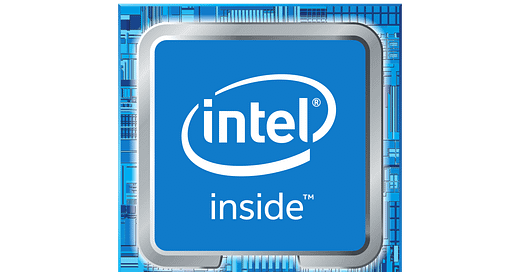Pat Gelsinger, who started at Intel in 1979, has stepped down after an unsuccessful 3.7 years as it’s latest CEO. This reflects the turmoil intel has faced over the past decade as it has fallen from the number one semiconductor company to number 8. In a symbolic kick in the gut, last month Intel was replaced in the Dow Jones Industrial Average by Nvidia. That was probably the last straw for the Intel board.
There was high hope at Intel in 2021 when Gelsinger took over. He was an “engineers engineer”, with deep understanding of the company and technology. It was assumed that he could bring Intel back to its glory days of the 1980s and 90s when Intel ruled their industry. Maybe that was the problem –– he was too embedded in the past, not willing to be radical in his thinking. And possibly nobody could have turned it around.
There was a long time period when Intel was the most important company in Silicon Valley — you could feel it everywhere you went in the valley from about 1980 through up until the recent 2010s.
For two decades their dominance of the PC CPU market was undisputed, partnering with Microsoft for the “Wintel” combination of CPU and operating system, then launching the “Intel Inside”marketing campaign. They followed that with the Pentium chips and “Intel Core” programs. Brilliant marketing and the best products helped them hold their top position and take more market share.
Anointment by Steve Jobs
By 2000 their products touched almost everyone, except the Apple loyalists. Then in 2005 Steve Jobs decided to switch Apple Mac CPUs to Intel, causing a major earthquake in the industry.
Intel was led from the beginning by charismatic founders Andy Grove, Robert Noyce and Gordon Moore. Moore was the first CEO, thought of a a genius of semiconductor design.
Grove was the second CEO of Intel, starting in 1992, and he was probably the most famous. His style defined the model for a tough, clever Silicon Valley leader. He was called the "guy who drove the growth phase of Silicon Valley” and tripled Intel’s size during his tenure.
2021 - The Accidental CEO
By the time Gelsinger took the CEO job in 2021, he had been away from Intel since 2009 and had experience as being CEO of Verisign and
a lot to live up to, and was a haphazard choice. The world around Intel had changed –– they were now the tired old elephant, looking obsolete and bloated, trying to keep up with the new guys.
The new leader was Nvidia, driving the AI chip industry to replace the CPU as the most important technology in our world. As Intel’s market cap sunk, Nvidia and other AI chip companies rose to take over.
Gelsinger tried to catch up with AI technologies, introducing the Gaudi product line in 2023, but it was far too little too late to make a difference. Nvidia was too far ahead already.
Can they change now enough to build it back? Not with the current acting leadership team of co-CEOs from the inside. They need a slightly crazy outsider to risk the company on reinventing the company. Otherwise they will become a quieter backend foundry for the new and future leaders. There is already talk of breaking the company up into parts.
It’s sad to see such a powerful presence of the technology world fade away. Companies like AOL, Yahoo and others went the same path, unable to come back. That’s why IBM is such an amazing story –– they beat the odds, adapted as needed into AI, and are now as viable as ever. Who will be next behemoth to fall? Google?
Who’s next?
Will Intel survive? Will they thrive or merge or slink into the background like the others did? Will they come back like AMD did? I’m hoping they find a dynamic new CEO with a lot of energy and creativity to bring them roaring back to the top. We’ll see.







